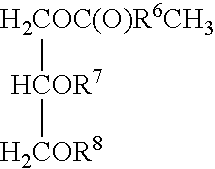Conveyor lubricants including emulsion of a lipophilic compound and an emulsifier and/or an anionic surfactant and methods employing them
a technology of lipophilic compound and lubricant solution, which is applied in the direction of lubricant composition, additives, base materials, etc., can solve the problems of affecting the lubricant solution, the lubricant solution is not diluted enough, and the conveyor line is not suitable for us
- Summary
- Abstract
- Description
- Claims
- Application Information
AI Technical Summary
Problems solved by technology
Method used
Image
Examples
example 1
Conventional Lubricants Exhibited Unacceptable Increases in COF with Wear and Wetting
A. Short Track Testing
[0139]These experiments demonstrated that conventional lubricant compositions showed unacceptable increases in coefficient of friction as they were used and wetted. Anionic surfactants were demonstrated to improve the performance of even conventional lubricant compositions.
Materials and Methods
Short Track Test Method
[0140]The conveyor included dual 3¼ inch conveyor tracks and the conveyor speed was 158 feet / min. After running for 35 minutes following the start of application of the lubricant, the COF was measured using two 12 ounce bottles of Miller Genuine Draft Light beer (Initial COF). Sixty minutes after the start of application of the lubricant, which is 20 minutes after the start of the water spray, the COF was measured again (Worn and Wetted COF).
Lubricants
[0141]The conventional amine conveyor lubricant (sold under the tradename Lubodrive TK, Ecolab, St. Paul Minn.) was ...
example 2
Anionic Surfactant Improves Lubrication by a Lipophilic Emulsion
[0159]These experiments demonstrated that a phosphate ester anionic surfactant improved lubrication by a lipophilic emulsion. Specifically, the phosphate ester containing lubricant had a smaller increase in coefficient of friction upon use of the conveyor and wetting.
A. Short Track Testing
Materials and Methods
Short Track Test Method
[0160]The short track test method was as described above in Example 1.
Lubricants
[0161]A premix of triglyceride oil with emulsifiers was prepared by mixing 83.3 g of the tri(caprate / caprylate) ester of glycerine (LUMULSE CC33K, Lambent Technologies Corp.) with 10 g of glycerol monooleate (LUMULSE GMO), and 6.7 g of 20 mole ethoxylated castor oil (LUMULSE CO-25) and stirring until homogeneous.
[0162]Dispersing the premix was accomplished by pouring the clear straw colored liquid as a thin stream into 900 g of stirring deionized water to give a dispersion. The dispersion was ...
example 3
Anionic Surfactants Improved Lubrication by a Soyate Ester Lipophilic Emulsion
[0172]These experiments demonstrated that anionic surfactants improved lubrication by a soyate ester lipophilic emulsion. Specifically, the anionic surfactant containing lubricants had a smaller increase in coefficient of friction upon use of the conveyor and spraying with water.
Materials and Methods
Short Track Test Method
[0173]The short track test method was as described above in Example 1 except that the track was a single 6.5 inch wide track that ran at 127 feet / min.
Lubricants
Soyate Fatty Acid Ester Emulsion
[0174]A premix of soyate fatty acid ester of sucrose with emulsifiers was prepared by mixing 83.3 g of the soyate fatty acid ester of sucrose compound (SEFOSE 1618S, product of Procter and Gamble Chemicals, Cincinnati, Ohio) with 10.9 g of glycerol monooleate (LUMULSE GMO-K, product of Lambent Technologies Corp., Gurnee, Ill.), and 5.9 g of 20 mole ethoxylated castor oil (LUMULSE CO-25, product of La...
PUM
| Property | Measurement | Unit |
|---|---|---|
| thickness | aaaaa | aaaaa |
| size | aaaaa | aaaaa |
| size | aaaaa | aaaaa |
Abstract
Description
Claims
Application Information
 Login to View More
Login to View More - R&D
- Intellectual Property
- Life Sciences
- Materials
- Tech Scout
- Unparalleled Data Quality
- Higher Quality Content
- 60% Fewer Hallucinations
Browse by: Latest US Patents, China's latest patents, Technical Efficacy Thesaurus, Application Domain, Technology Topic, Popular Technical Reports.
© 2025 PatSnap. All rights reserved.Legal|Privacy policy|Modern Slavery Act Transparency Statement|Sitemap|About US| Contact US: help@patsnap.com


